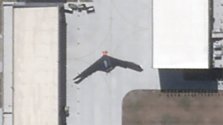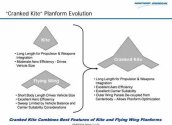The US made several cranked kite designs including the X-47B so does the US also lack engines with sufficent thrust for a pure flying wing?I'm still trying to find a plausible reason for why they'd forego a pure flying wing design. It doesn't make sense to sacrifice stealth for aerodynamics in a subsonic bomber.
I wonder if maybe Chinese engines currently do not provide sufficient thrust for a pure flying wing bomber of this size and weight. At least not in a 2-engine configuration. They can build a 4-engine B-2 size bomber. But not a 2-engine B-21 size bomber. So they gave this a cranked wing design to reduce aerodynamic drag, and allow the bomber to fly with only 2 engines.
The H-20 will probably be a larger 4-engine pure flying wing bomber like the B-2.
You are using an out of date browser. It may not display this or other websites correctly.
You should upgrade or use an alternative browser.
You should upgrade or use an alternative browser.
Chinese UCAV/CCA/flying wing drones (ISR, A2A, A2G)
- Thread starter VESSEL
- Start date
The US made several cranked kite designs including the X-47B so does the US also lack engines with sufficent thrust for a pure flying wing?
Isn't the X-47B much smaller? And uses only a single engine? And carrier based?
The issue isn't about whether China can build a pure flying kite aircraft. They obviously have built several already. The question is whether they can build one of the size and weight of a B-21 while powered by only 2 engines.
Now that you know cranked wing has higher drag than pure flying wing, shouldn't your question be: can the US build a GJ-X sized drone while powered by 2 engines?Isn't the X-47B much smaller? And uses only a single engine? And carrier based?
The issue isn't about whether China can build a pure flying kite aircraft. They obviously have built several already. The question is whether they can build one of the size and weight of a B-21 while powered by only 2 engines.
So they gave this a cranked wing design to reduce aerodynamic drag, and allow the bomber to fly with only 2 engines.
Upon re-reading that, it is clearly nonsense. I shouldn't have worded it that way. Cranked wing has benefits, but reducing aerodynamic drag in the subsonic regime is not one of them.
But it doesn't change my feeling that the cranked wing is a design compromise, rather than a design feature. The B-21 shape seems optimal for maximizing the stealth and range of a subsonic bomber. Any deviation from it (even the B-2 shape) is sub-optimal. The B-21 probably uses variants of the F135 engine. China doesn't currently have a comparable engine. And that's why I suspect they may have had to compromise on the shape in order to produce a 2-engine bomber of comparable size and weight as a B-21.
Maybe someone more knowledgeable about aerodynamics can explain whether or not this is a reasonable conjecture.
The B-21 uses PW9000s. They’re not based on the F135 but the PW1000s.Upon re-reading that, it is clearly nonsense. I shouldn't have worded it that way. Cranked wing has benefits, but reducing aerodynamic drag in the subsonic regime is not one of them.
But it doesn't change my feeling that the cranked wing is a design compromise, rather than a design feature. The B-21 shape seems optimal for maximizing the stealth and range of a subsonic bomber. Any deviation from it (even the B-2 shape) is sub-optimal. The B-21 probably uses variants of the F135 engine. China doesn't currently have a comparable engine. And that's why I suspect they may have had to compromise on the shape in order to produce a 2-engine bomber of comparable size and weight as a B-21.
Maybe someone more knowledgeable about aerodynamics can explain whether or not this is a reasonable conjecture.
So I guess this thing is used for long range ISR? Kind of similar to global hawk?
Likely long range/endurance unmanned strike bomber (but naturally would likely have some ISR capability because it'll have some sensors after all
The other large, B-2 wingspan flying wing is likely more purpose built/optimized for long range/endurance ISR.

More similar to RQ-180 than global hawk
Can’t wait till TWZ folks freak out and write a 1500 word article on this.
All designs are compromises, the biggest advantage of cranked wing is it gives more room to move internal equipment around to match CG to center of lift, i.e. "outer-wing decoupled from centerbody - allow planform optimization", this is especially important when you have internal payload size requirements.Upon re-reading that, it is clearly nonsense. I shouldn't have worded it that way. Cranked wing has benefits, but reducing aerodynamic drag in the subsonic regime is not one of them.
But it doesn't change my feeling that the cranked wing is a design compromise, rather than a design feature. The B-21 shape seems optimal for maximizing the stealth and range of a subsonic bomber. Any deviation from it (even the B-2 shape) is sub-optimal. The B-21 probably uses variants of the F135 engine. China doesn't currently have a comparable engine. And that's why I suspect they may have had to compromise on the shape in order to produce a 2-engine bomber of comparable size and weight as a B-21.
Maybe someone more knowledgeable about aerodynamics can explain whether or not this is a reasonable conjecture.
To achieve the same IWB size with a pure flying wing you might need a much bigger aircraft than needed, so after you factor in everything, the increased size might hurt RCS, and the increased mass and limitations to planform might prevent optimization and hurt efficency.
This is why everyone think the large flying wing drone is ISR and the cranked wing is for strike, ISR does not have IWB requirements.
Also remember aircrafts are 3D objects and airfoils aren't rectangles, just because the leading and trailing edge are at certain places does not mean internal volume extend to the edge.

